The miracles that are called PH lamps – Part 3 – PH Table Lamps
A series on the lesser known lamps by Poul Henningsen.
Poul Henningsen (1894–1967) was an architect, author, critic and creator of many stylish and timeless lamps. His pioneering analyses that led to the PH pendant, in 1925, concerned the relation of technical aspects like colour reproduction, glare and shadows versus the importance of light for our well-being. Table, floor and wall lamps, all with the famous three-shade design, soon joined the pendant. Louis Poulsen has always produced the lamps designed by Poul Henningsen.
-
 Table, desk and floor lamps, Catalogue B 50, 1953 (from the Palainco archive).
Table, desk and floor lamps, Catalogue B 50, 1953 (from the Palainco archive).
-
At the time of his death in 1967 Poul Henningsen had designed more than 100 lamps of which Louis Poulsen nowadays still sells more than twenty. We would like to give you an impression of his amazing work, with a strong focus on his lesser-known designs. In this article, we will focus on his table lamps, or in Danish bordlamper.
-
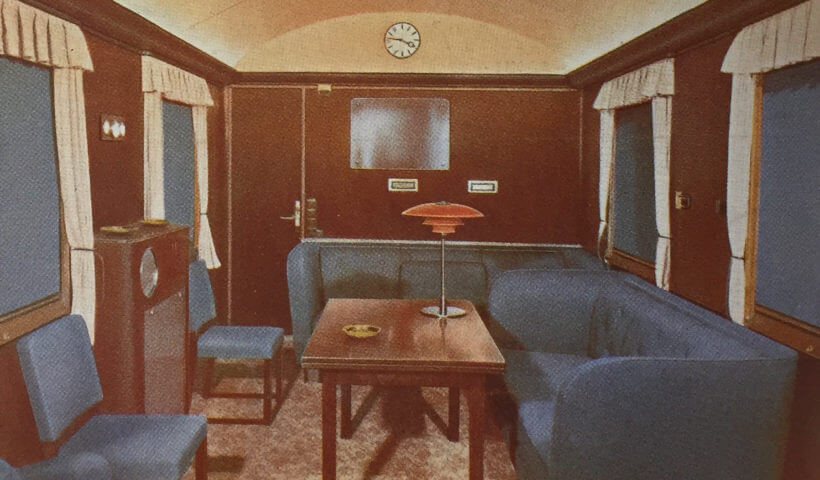 Fit for a king... the new 1938 train compartment of Danish King Christian X included a fixed PH Table lamp with copper shades (courtesy of Louis Poulsen – ‘Light Years Ahead’).
Fit for a king... the new 1938 train compartment of Danish King Christian X included a fixed PH Table lamp with copper shades (courtesy of Louis Poulsen – ‘Light Years Ahead’).
-
We will start with the most iconic PH Table Lamp, the one that was used in the train carriage of King Christian X. In Light Years Ahead, we read that his lounge carriage fitted with “Brazilian rosewood walls and furniture upholstered with hand-woven, wooden material,” also held the PH Table Lamp with copper shades.
-
 Sizes as in the Louis Poulsen catalogue Saa enkel er PH lampen from 1941 (from the Palainco archive).
Sizes as in the Louis Poulsen catalogue Saa enkel er PH lampen from 1941 (from the Palainco archive).
-
The PH Table Lamp was, like most other PH lamps, available in different variants; a customer could choose between screens made of opal glass, frosted glass and metal. They were made in different colours and also available in several sizes. As is true of all PH lamps, the Table Lamps age beautifully and over time seem to become even more distinguished.
Initially the shades were made of glass, but during the Great Depression in the 1930s, reasonable prices became a deciding factor in sales and so Louis Poulsen started to produce a series of models consisting of cheaper metals.
-
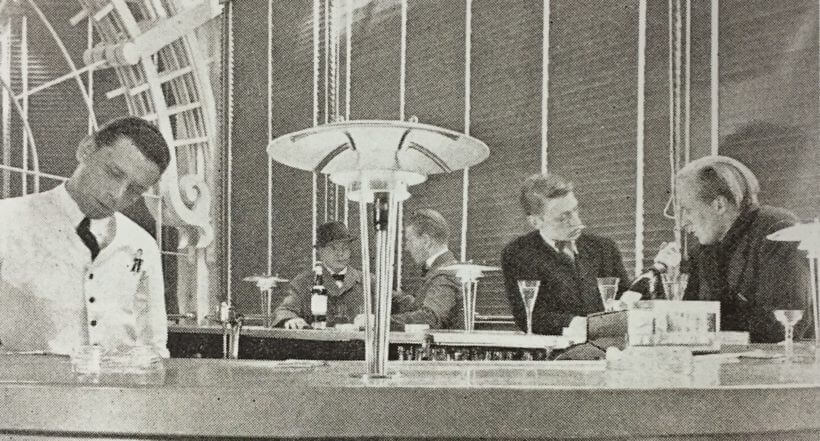 The lamps at the Blanche Bar were low so you could easily look each other in the eye.
The lamps at the Blanche Bar were low so you could easily look each other in the eye.
-
Poul Henningsen has designed many other extraordinary table lamps, which are no longer in production. The Blanche Bar at Copenhagen’s famous amusement park Tivoli, for instance, featured table lamps on both the bar and the tables. Now that must have been a wonderful sight!
Of course, the setting was well thought out by Henningsen. The lamps were low enough for two people to be able to see each other over the top of them. Even more interesting, is that it was possible to place a serving tray directly on top of the shade. The technical aspect of the design was so well thought through, that even after the lamps had been used for several hours the upper shade would remain cool. This feature becomes apparent in the following picture.
-
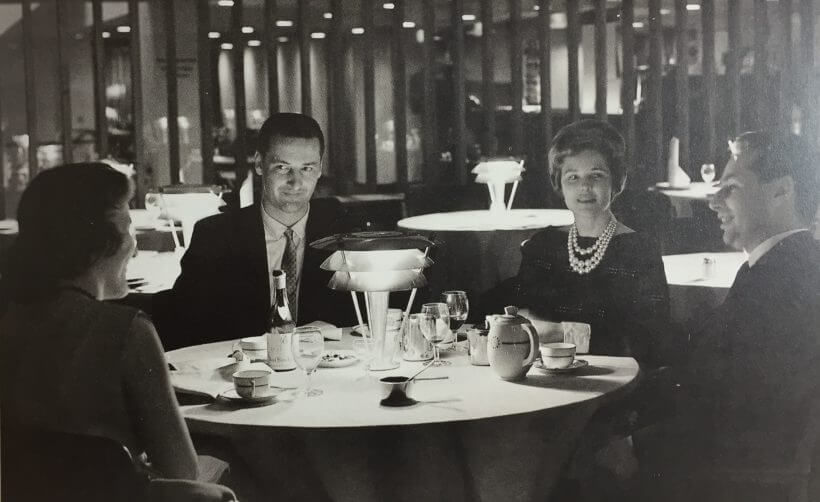 The construction permitted to put dishes on top of the screen (both pictures above courtesy of Louis Poulsen – ‘Light Years Ahead’).
The construction permitted to put dishes on top of the screen (both pictures above courtesy of Louis Poulsen – ‘Light Years Ahead’).
-
These lamps were produced for the restaurant at Hotel Marina 22 years after the ones in the Blanche Bar in Tivoli (source: ‘Lights Years Ahead’, Poulsen 2000).
-
 Poul Henningsen himself used the revolving writing lamp in his study at his home on Brogaardsvej in Gentofte (courtesy of Louis Poulsen – ‘Light Years Ahead’).
Poul Henningsen himself used the revolving writing lamp in his study at his home on Brogaardsvej in Gentofte (courtesy of Louis Poulsen – ‘Light Years Ahead’).
-
Another wonderful example of PH’s range of table lamps is the PH Desk Lamp 4/3. This lamp was intended for the American market and was usually supplied with three holes in the massive base plate for fastening with countersunk screws. The lamp could be swung away when not in use.
The three lamps below were shown in Catalogue B 06 that was published in 1936.
-
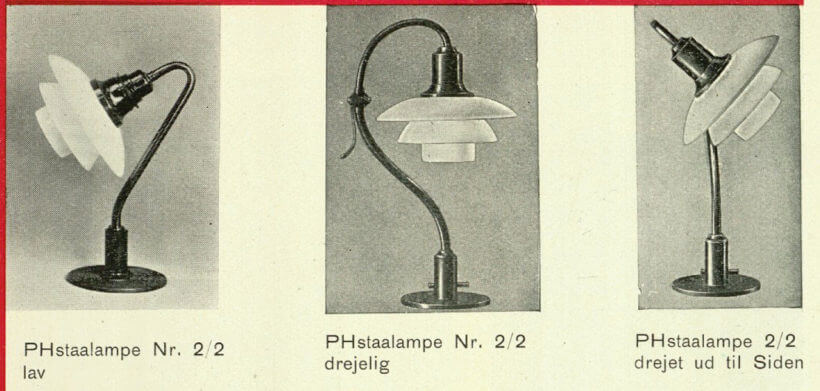 In Louis Poulsen catalogue B06 from 1936 three rather similar lamps were presented (from the Palainco archive).
In Louis Poulsen catalogue B06 from 1936 three rather similar lamps were presented (from the Palainco archive).
-
The last one seems, at first glance, the most ornate and almost frivolous lamp that could be used on a table. But it was in fact designed for a special purpose: to illuminate a piano. The PH Piano Lamp can be turned up and down using a hinge that sits just above the base of the lamp. This way the lamp can take all positions between the two shown in the next pictures (Catalogue B 1931-32). This construction made the lamp not only suitable to illuminate a piano, but also permitted it to contribute to the overall lighting of the room.
-
 The two extreme positions in which the piano lamp can be turned up...
The two extreme positions in which the piano lamp can be turned up...
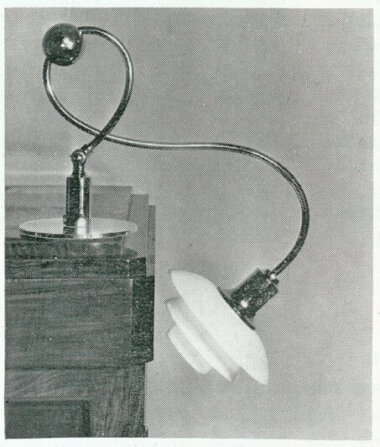 ...and down (both pictures from original Louis Poulsen catalogues, from the Palainco Archive).
...and down (both pictures from original Louis Poulsen catalogues, from the Palainco Archive).
-
This is the second article in a series on the lesser-known PH lamps. In the first article we showcased a selection of his wall lamps, in the second one we highlighted his floor lamps and in future editions we will reveal some astonishing ceiling lamps.
If you would like to be the first to read articles on designers and special designs, please subscribe to our newsletter.
-
- Literature: Ove Hansen, Steen Jørgensen, Tina Jørstian, Poul Erik Munk Nielsen, Kurt Nørregaard, and Allen de Waal, Light Years Ahead: The Story of the PH Lamp, ed. by Tina Jørstian and Poul Erik Munk Nielsen (Copenhagen: Louis Poulsen, 1994).
Unless otherwise stated, all material is sourced and/or generated internally. All rights reserved.
- Text: Palainco, Koos Logger & Ingrid Stadler.
- Image sources: Courtesy of Louis Poulsen – ‘Light Years Ahead’, Bent Ryberg, Louis Poulsen - various catalogues from the Palainco Archive.
The article and its contents may not be copied or reproduced in any part or form without the prior written permission of the copyright holders.
Published on: 29 August 2016